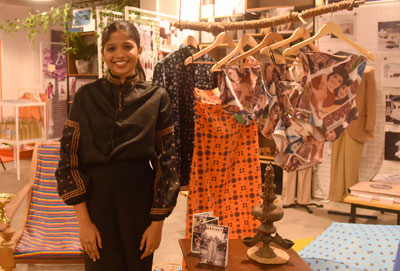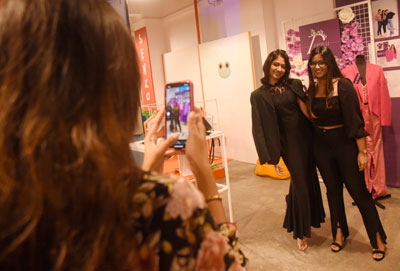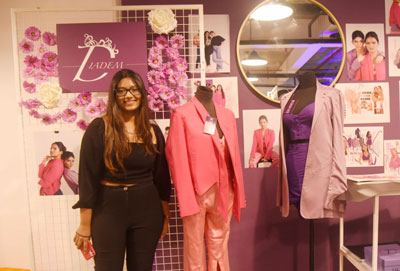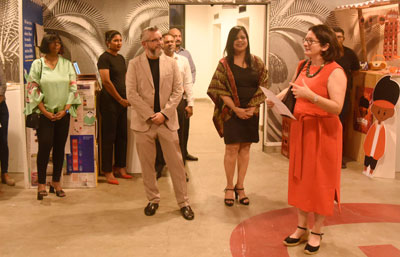In an exquisite amalgamation of colour and artistry, the Academy of Design (AOD) kickstarted December by presenting their annual Mercedes Benz Fashion Week Sri Lanka (MBFWSL). Powered by Dimo, this event aims to uplift Sri Lankan fashion to new levels, creating international opportunities for talented and upcoming local designers to unveil their work to the eye of the public. Their designs took the runway from December 1st to the 3rd of December.
The New Local, the theme for Day One aimed to exhibit both innovation and sustainability, portraying a vivid blend of heritage craft textiles in a fusion of traditional Lankan attire with futuristic twists. The show begins with the opening segment; The Future of Craft by Shalini Wickramasuriya; “a curated showing of conceptual development from the AOD fashion class of 2023”.
 |
 |
 |
 |
Next up was Designer meets Artisan, a display by individual designers of their brands. The influence of the last two years and the current economic crisis inspired Ashleen Adhikari to reach out to small local units and form her designs, particularly from those materials. “This is my way of trying to tell their stories through my work,” she says, presenting at the MBFW for her second consecutive year, emphasizing the importance of the theme ‘New Local’ being a strong integration of Lankan culture.
The runway was brightened with Malka, inspired by the tropics and batik techniques, giving traditional craft a fresh modern look, followed by Anna Ceylon in which the designs contained significant motifs from posters, magazines, and colonial architecture. Nimna (Asteroid 1.0) presented contemporary local textile craft through a vivid comicality of graphic streetwear, followed by the contrasting handwoven materials of Udak and the black-and-white androgynous collection Mendes Ceylon “encapsulating the independent, resilient spirit of the Ceylonese girl.” Next came, Twisting Macrame x Celine Hansen (Danish Designer) displaying a marriage of Sri Lankan craft and international design through authentic streetwear, followed by the brand Kasun which aimed to redefine masculinity through the addressing of fluidity in menswear. Abstract Japanese artwork was the evident inspiration for Chihiro “Kala”, followed by Eco di Babara – a collection that explored the concept of ‘deconstructed vintage’.
The winner of the Future Craft Award presented by Deputy British High Commissioner Lisa Whanstall, was Artroom Ceylon by entrepreneurs Kasun Jayawardana and Udaya Wickramage, both university lecturers by origin. This was their second collection on MBFW, and with intricate ornamentation topped with vibrant colours illuminating the runway, it was clearly noteworthy. “We were completely taken aback,” said Kasun of the award. He adds that the name of their brand was called ‘Craft salad’ due to the amalgamation of the varieties of heritage craft textiles through experimental fashion – from batik to crotchet, to lace. “We want to create not just designs, but artwork.”
Following them was the collection Nilly by Nilshani; motivational speaker with Down Syndrome, displaying women’s resort wear under the title ‘Birds of paradise’.
Asma Harifa’s concept “Padma Kaveya” came about after her visit to Kandy where she drew inspiration from the materials of monks, experimenting with hand-made dye to recreate the colour through her designs. “I wanted to bring out a very authentic local touch to this collection,” she says, having thoroughly studied the dyeing process of such materials.
The last few presentations of the night were Saarau Ahmed’s unisex 90s’ streetwear collection; Wasteland Dwellers, t.s.s by Thilini Silva’s minimalistic but rich, unconventional batik drape designs, and lastly, Urban Drape’s ‘New Ceylonese Globe Trotter’ collection which was an edgy, innovative extension of traditional craft and urban denim.
With smiles all around from new faces and nods of approval from the famous and familiar, the night was a success, with a celebratory afterparty being hosted at the Colombo Love Bar.
Shannon Salgadoe writes on Day 2 and 3 of the Mercedes-Benz Fashion Week
The second day of the Mercedes-Benz Fashion Week Sri Lanka 2022, which focused on emerging designers, took place on December 3. The event was one of two events that took place at the AOD’s Innovation Tower as part of the Sri Lanka Design Festival 2022, the other being the Academy of Design (AOD) Grad Exhibition. The evening opened with a segment celebrating the AOD alumni who have gone on to win or compete for international awards globally.
Amesh Wijesekera’s brand AMESH embodied colours of hope, renewal and resilience in its trans-seasonal collection ‘Paddy Field Play’. Artisanal hand-weaving techniques, hand-knitting, and crochet were seen in the statement pieces which also utilised factory off-cuts and dead stock textiles. The winner of the 2022 LVMH Prize, Amesh was also the recipient of the International Achievement Recognition Award.
‘Grudge’ by Nishaka Hettiarachchi, a casual menswear collection drawing inspiration from construction clothing and rail construction sites of the 1900s, was a new interpretation of denim that also represented Sri Lanka at the Graduate Fashion Week 2021 in London.
Showcased at the Redress Design Awards, the collection ‘Take Me Home’ by Ruwanthi Gajadeera links urban spaces, the great outdoors, and the movement in between. Emphasising adaptability with versatile hemlines and backpacks that can convert into jackets, the pieces were made with Lyocell thread, recycled polyester and nylon threads. Information on upcycling and care information was provided on a QR label.
Another collection shown at the Redress Design Awards was Nawoda Bandara’s ‘REALITE’ which also happened to be featured in Vogue Hong Kong. The genderless, multi-seasonal collection aims to empower the LGBTQ community who are faced with perpetual discrimination and harassment. Materials used in this collection were sourced from industrial sites with the conscious minimalization of plastic. Nawoda was awarded the Industry Young Blood Sustainability award later that night.
The collection SO4 by Ruth Weerasinghe, previously shown at Shenzhen Fashion Week, promoted the concept of ‘unwanted waste’ by revaluing waste. The sustainable brand reused industrial synthetic waste and textile waste to repurpose it and foster awareness of industrial pollution.
‘The Queen’s Gambit’ by Natharlea was a knitwear-based collection made in collaboration with British Alpaca and KALARO, which sought inspiration from the flora and fauna of the island. The collection, designed and made in Sri Lanka features 100% cotton mixed with alpaca linen sourced from the UK.
The next segment highlighted the most powerful future brand proposals put forward by the graduating class of 2022.
Keshawee Raddella’s brand BLAZE combined futuristic technology and minimalistic lifestyles with inspiration drawn from Tesla’s iconic brand presence and technology. The designs which were in collaboration with TIMEX Garments were bold, sleek, and multi-functional with minimal detailing in the form of narrow LED strips.
Taking inspiration from psychedelic fungi and their healing properties, Sajani Samarakoon’s brand VOID in collaboration with MAS Ayathi, aimed to encapsulate the liberation that comes from being a part of something larger than ourselves. Sajani was also the recipient of the award for Best Future brand Proposal.
SENZO by Dulaj Wegapitiya displayed sensory-friendly, modern, and gender-neutral clothing for kids. The collection which tied up with Hela Apparel Holdings was inspired by 90s hip-hop and Japanese streetwear.
Some of the promising established young designers had the chance to show their collections in the next segment.
In a marriage of the physical and digital, Pubudi Lawanya’s ‘phygital’ collection ‘CODE SYNTH’ blurred the lines between virtual and reality. Each physical look seen on the runway was accompanied by its corresponding digital twin to be worn by an avatar in the Metaverse. The designs were inspired by 1980s album art, iconic music idols, and vintage pilot space suits. Pubudi was awarded the Innovation in Fashion Award.
Clean construction and a minimal aesthetic were the main elements in IKIGAI’s collection which featured designs from sub-brands IKIGAI RTW and IKIGAI Bridal. Incorporating a less-is-more attitude in their all-black and all-white designs, the brand displayed timeless silhouettes with a subtle edge. The accompanying flowers, jewellery, and accessories were by Frances Decor, Olive Yu, and Navya respectively.
The next segment of the evening showcased the industry collaborations by some of the graduates.
Navinie Pathirana’s collection ‘Navaada’ in collaboration with MAS Active and Hela Clothing Apparel was a colourful series of athleisure garments with each outfit representing social issues faced by women and shedding some light on them.
Tharaka Dissanayake took us into the future with his take on the year 2050 featuring a dystopian theme in his menswear collection, done in collaboration with Norlanka Manufacturing.
For her collection created in collaboration with MAS Kreeda, Shavindi Wijeysooriya demonstrated the duality of human nature with designs inspired by the human form. She also used optical illusions to further reiterate the ugly side that remains hidden in human beings.
Shasha Mahanama’s KASA collection was inspired by robes worn by Buddhist monks and the Four Noble Truths of Buddhism and utilised deadstock knit yarn and denim waste to reflect the philosophy.
Women’s empowerment was the theme of Kethmi Ubeyrathna’s collection in collaboration with STAR Garments. The black and white designs were representative of the balance of masculinity and feminity within each individual regardless of gender.
Ayesha Zikker’s collection ‘Kintsukuroi’ takes inspiration from the Japanese art of restoring broken pottery by mending the breaks with gold lacquer. Her multi-textural collection which promotes low wastage used various Japanese crafts and techniques in the designs.
Using the Cosmos as her source of inspiration, Nicola Perera’s showcase was influenced by outer space and the 1950s biker jacket. The colours and the ombre effect on her outfits represented what is seen in the Aurora Borealis. Her collection was in collaboration with Orient Design. Nicola was also the winner of the Fashion and Textile award presented at the end of the evening.
Bringing to light the issues of coral bleaching in the Great Barrier Reef, Fathmath Ana’s collection in collaboration with the Bobbin Group, was a throwback to the 1990s with the Versace-inspired slit dresses and shoulder pads. The luxury clothing collection with its oceanic palette looked to give women a touch of empowerment with ready-to-wear items.
Day 03 of the Mercedes-Benz Fashion Week Sri Lanka 2022 had the theme New Gen.
Amanda Munasinghe’s multi-functional collection ‘Li Mei’ meaning plum blossom was influenced by the women’s suits of the 1960s and 1970s as well as fantasy character clothing. The collection used upcycled fabrics and zero-waste techniques to highlight minimising waste in the fashion industry.
The collection ‘Inhumanity’ in collaboration with the Bobbin Group and Freudenberg Lanka and Vilene International was designer Sesara Wanninayake’s avenue to address animal cruelty using COVID-19 as a parallel to describe the isolation of caged animals. The colour story of red, blue, and yellow was also significant in discouraging animal cruelty in the fashion industry.
The ‘Navigator’ collection by Roshita Fernando features handloom and crochet to create resort wear made using unsold and leftover thread and yarn from the retail market. The collection was centred around empowering cancer patients who carry on despite the effects of chemotherapy.
Chathurika Liyanage was inspired by European architecture such as the Heydar Aliyev Centre in Azerbaijan, the Valencia Aquarium, and Auditorio de Tenerife in Spain. Her collection featured garments in Boquete fabric and displayed geometric structures in the designs.
Somil Katuwavila’s collection drew on the Edwardian era and the Art Nouveau movement to create womenswear which was a mix of casual and elegant. His inspiration could be seen in his use of colours and patterns as well as in details like ruffles, collars, and sleeves.
Ruwandhi Silva’s debut collection ‘Leela’ for the resort wear brand Kanya Leela was inspired by lingerie and 1920s silhouettes. With a focus on femininity, this collection was geared towards women with curves and exuded an elegant sensuality with the colour story and dreamy fabrics.
KUSHIRO, the genderless collection by Senodi Ranatunga was inspired by gender equality and the goth subculture. Elements of human anatomy were also seen in the designs alongside elements of Christian religious architecture.
A versatile collection that addressed the inequality of Sri Lanka’s ancient class system, Kule by Kavindhi Wanigasinghe featured traditional elements with a twist and prints inspired by traditional tools and symbolic items in an androgynous ready-to-wear streetwear collection.
Collaborating with Vogue Tex, Vimashini Dissanayake created a collection that drew on Gothic architecture and silhouettes to take a look at the light and dark sides of the culture.
Nawoda Bandara showed her collection ‘No Rules Like Dreams’ which was inspired by her experience with sleep paralysis. The collection also incorporated postmodern architecture, alt-rock subculture and surrealism and featured bold colours and silhouettes with elements of leather and cane. Nawoda who also showed her previous collection on Day 02 was given the opportunity to show her collection at the Graduate Fashion Week in London next year.
Leave Comments